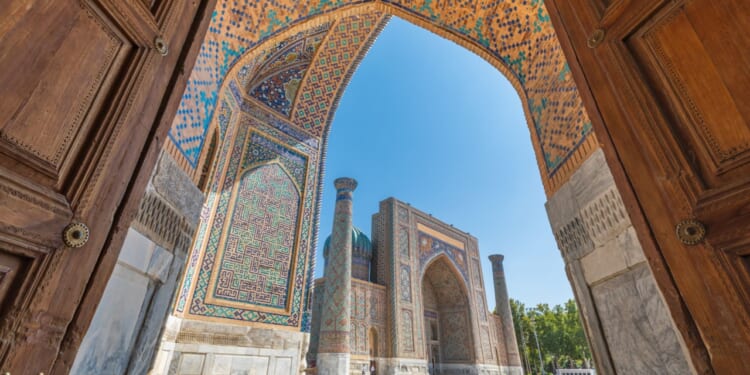Central Asia’s “steppe children” are growing up and redefining world order in the twenty-first century.
The era of global affairs focused exclusively on great powers is ending. Not with a single dramatic event, but through a steady, quiet redistribution of agency across the world. Nowhere is that shift more visible—or more surprising—than in Central Asia. For years, Central Asia (Kazakhstan, the Kyrgyz Republic, Tajikistan, Turkmenistan, and Uzbekistan) was perceived as a chessboard, a fly-over zone, a periphery. Today, it is becoming something quite different—a cluster of enfranchised middle powers.
The rise of Central Asia’s middle powers is forcing us to rethink what “great power competition” even means. The five countries of this region—each in its own way—are now shaping regional dynamics instead of being shaped by them. They no longer see or define themselves by the interests of their large neighbors—Russia and China, but instead pursue bilateral and coordinated regional agendas that first serve their own interests.
Central Asia’s Coming of Age
Each nation in the region is practicing a form of “multi-vector” diplomacy that maintains open lines of communication with global capitals, including Washington, Moscow, Beijing, Brussels, Ankara, and Tehran. They regularly convene forums that attract global attention to critical regional issues, including cyber connectivity, security, water management, and environmental security. They perceive themselves as coming of age.
When Russia invaded Ukraine for the second time, the resulting international sanctions regime effectively closed Central Asia’s access to the northern transport corridor through Russian territory. This derailed much of the region’s trade. The resulting economic disruptions forced Central Asian leaders to make Darwinian decisions, reorient their commercial strategies, and adapt their diplomacy.
The five Central Asian countries, plus Azerbaijan and Georgia, worked to rapidly develop alternative trade routes, implement infrastructure improvements, and adopt cooperation mechanisms to accelerate freight transit. The resulting Middle Corridor is a rapidly growing Trans-Caspian route linking China and Europe via Central Asia, the Caspian Sea, and the Caucasus.
Middle Corridor Infrastructure as Strategy
What began four years ago as a logistical adjustment has become a strategic reorientation. Now bridging the Caspian and the Black Sea, Central Asia is becoming an energy and transport hub at the very center of Eurasia. Capitalizing on their central geographic location, Central Asian capitals are turning the tables on their large neighbors who seek to control regional transit and, by extension, the economies of the vast steppe.
However, by gaining direct access to global markets via the Middle Corridor, the region’s economies are creating supply chains and economic realities that are independent—that do some business with Beijing and Moscow, but on their own terms. These countries no longer see themselves as fragile objects of competition, but as emerging arbiters of it.
Central Asian countries have partnered with their South Caucasus neighbors, the United States, Europe, and Türkiye to coordinate customs reforms, build ports, digitize trade flows, and connect themselves directly to Europe and the Indo-Pacific. The Middle Corridor is no longer just a trade route. It is becoming a corridor of sovereignty—a symbol of how middle powers can use infrastructure as a strategic tool. By attracting substantial global investment to improve market access, Astana, Tashkent, and the region’s other capitals have learned that connectivity is power.
From Blocs to Webs
This remarkable turnaround reflects a broader evolution in multilateralism. For decades, international cooperation was best described as a wheel, with a great power at the hub and other states as spokes. Today, that structure is changing, as influence, authority, and power flow more horizontally. In the vacuum created as the United States, China, Russia, the European Union, and the rest of the world undergo relational realignments, dense, overlapping partnerships are forming between middle power states that fracture traditional relations. As a result, we now appear to live more in a web than a wheel.
A proliferation of small, focused, state-to-state partnerships reflects this new shape of global relations: pragmatic, flexible, situational. It’s less about “blocs” and more about balancing networks. Central Asia is a particular case in point. Through a series of cooperation frameworks (such as the C5+1 format) that separately link the region with a wide variety of countries, Central Asia has created unique agreements and mechanisms to engage with and benefit from traditional multilateralism. These frameworks are backed by robust summitry that connects the region’s leaders personally with their global peers in the quest to balance partnerships and diversify alliances and trade.
A Laboratory of Change
Membership in the Organization of Turkic States ties Central Asia to the west through cultural diplomacy and trade. Various other cooperation platforms still anchor regional coordination with China and Russia, but (as seen with the Shanghai Cooperation Organization and the Collective Security Treaty Organization) Central Asian participation comes at the cost of concretely addressing the region’s own interests—not just that of Moscow or Beijing. In that sense, Central Asia is not a periphery of great power politics; its elevation to a position of global influence makes it a laboratory for the future of multilateralism.
But there is both promise and peril in this new political environment. Just west of Central Asia, in the South Caucasus, where the real challenge today is not ending war, but building a durable peace after war. The 2020 Nagorno-Karabakh conflict showed that external powers, whether Russian peacekeepers or Western mediators, could only do so much. Largely eschewing external engagement, Armenia and Azerbaijan came to terms with each other, seeking to secure lasting stability through their own agency.
The same lesson applies to Central Asia. Enfranchised middle powers carry new responsibilities: to manage disputes, to cooperate, and to prevent new sources of instability. Their sovereignty is strengthened not only by balancing great powers but by balancing one another.
Central Asia’s Multipolar Patchwork
This regional enfranchisement is part of a larger story across Asia. Across the continent, we see a concert of middle powers (ie, India, Japan, Indonesia, Vietnam, South Korea, and now, Kazakhstan and Uzbekistan) all hedging, balancing, and innovating. Each seeks strategic autonomy, and none wants to choose sides. This is what the new multipolar Asia looks like—a patchwork of agency, not an axis of allegiance.
But there’s a risk in too much strategic autonomy, creating an environment with multipolarity but without multilateralism. Imagine a crowded and contested group of neighboring countries without shared rules. Here again, Central Asia offers a model in which states have shown that multi-vector diplomacy can be principled and not paralyzed, maintaining autonomy without isolation.
Four Lessons for a Shifting Order
For North America, Europe, East Asia, and elsewhere, long accustomed to leading global institutions, there are four considerations when seeking to understand middle power countries like those in Central Asia.
First, the old division between great powers and small states no longer prevails. Between them lies a growing class of middle actors who will increasingly determine how global competition plays out.
Second, middle power countries need to be engaged through dialogue and not directives. Partnerships like the C5+1 or the EU’s Global Gateway will succeed only if they respect local agency and work in partnership.
Third, connectivity should be treated as a strategy. Rail lines, ports, and digital corridors are not technical projects; they are the new instruments of statecraft.
Fourth and finally, it is time to move beyond containment thinking. Central Asia’s rise is not just about balancing China or Russia. It is about asserting sovereignty in the middle spaces of the world.
This is, in effect, a quiet revolution in self-determination, in which middle-power countries no longer see themselves as objects of great-power competition but instead define themselves by pursuing policies of their own making. With a new self-perception comes a de facto rebalancing of agency from great powers to nations with significant influence, major economies, and often greater flexibility to act. Central Asia’s rise into this grouping is fueled in part by its vast reserves of highly sought-after strategic minerals and rare earths, as well as its geostrategic location.
From Victims to Authors of Alliances
We are entering an age of strategic enfranchisement with power today developed through networks, partnerships, and newfound credibility. This makes the middle powers—especially those of Central Asia—essential to the future of order. They are small enough to remain pragmatic, but large enough to matter. They are learning to navigate a world of many centers—not as victims of competition, but as authors of cooperation.
Their rise compels us to rethink what great power competition even means. The world’s center of gravity is shifting, spreading, and flattening—from the Atlantic to the Caspian, from the Caspian to the Pacific. The challenge now is to embrace a multilateralism that reflects this reality—one that recognizes not just the great powers of the past, but also the middle powers of the future.
About the Author: Eric Rudenshiold
Dr. Eric Rudenshiold served for four years as the US National Security Council’s Central Asia Director under Presidents Trump and Biden. He is currently a Senior Fellow at the Washington office of the Caspian Policy Center.
Image: Emily Marie Wilson / Shutterstock.com.


















